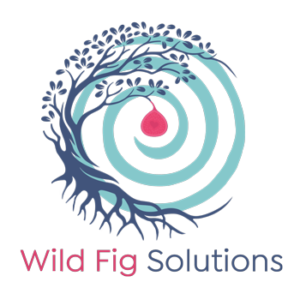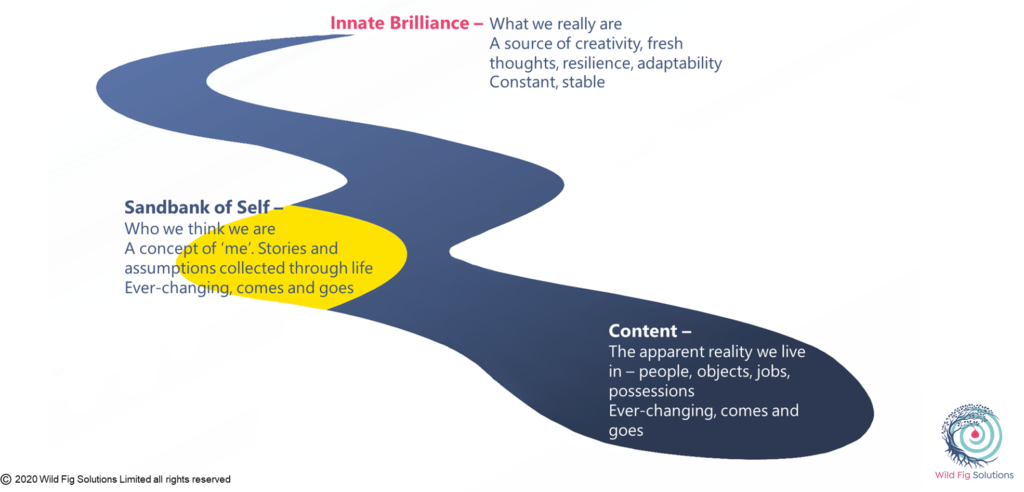Who you ‘think’ you are is not who you are. Release the restriction and realise you are the flow.
I was working with a client this week, sharing the metaphor of a river to remember the context of the work we’re doing together (see incredible artwork below!). Our work is upstream, at the source, from where you gain the greatest downstream effect.
Then, the great thing about working in collaboration with another mind happened, he suggested an addition to the metaphor — the sandbank of self.
What is the self?
The self is the idea of who you are that has developed over the years and that — like the vast majority of people — you may think is who you are, all you are. Something to be maintained. It is apparently you who likes cake, but not cheese, who is always cold, who is an on-time or a late person, who can do detail or not, who earns this kind of money and wears these types of clothes.
As the brain collects these ideas it creates a rule book — ‘Who I am: the rules to a successful life’ — against which it checks what’s being done and how, to see where it falls within the rules. Is this good or bad. Are we safe or not.
It makes sense. Success as a child equals believe and do what the people in authority say because they provide my food and shelter.
But we can carry this rule book unrecognised, unexamined; sleepwalking through life, running the same programme that’s been there from the start. Repeating the same patterns over and over. Even if we apparently don’t like them.
Now as adults we have the chance to see what’s going on and start to, not just re-write, but throw out the rule book. Every last line of it!
River of flow
In the beginning there is just a river of life living, flowing. The baby cries, sleeps, poops, learns to roll, to crawl. It doesn’t matter if someone tells them to do something more or less. It doesn’t influence what the baby does. It’s just living, growing, developing, discovering. It can’t not. The river flows freely.
Then around two the self begins to arise. The teribble two’s. Because now this small being is beginning to believe in this concept called ‘I’, rather than the only and whole I that it’s known itself to be until then. Apparently ‘I’ was a good baby for crawling and walking. And ‘I’ was bad for crying so long. Somehow ‘I’ did all that.
The sandbank of self has begun. Grain by grain, thought-sand has started to be deposited on the banks. Each grain, another rule in the rule book of ‘Who I think I am’ and what I am responsible for that’s good or bad and what I need to do or be in order to be safe.
This feeling of a ‘me’, separate from others, brings a confusion that wasn’t there as a baby. It brings an anxiety. Over here in this body doesn’t feel safe like it did before when all that was known was movement as and connection with everything.
So the inevitable response to this anxiety is an attempt to regain safety, believed to be found through control and certainty.
So yes tantrums because I might get a sense of control by getting you to act a certain way or getting what I want. And yes doing what you say because you seem to like that which means I’ll keep being fed. Certainty for a moment. Safe.
And so we grow older. Having gone through toddler years, most kids have had alot of thought-sand dumped on their sandbank of self. Apparently there’s ALOT we can do right and wrong! Alot of ways to stay safe in this world and over which ‘I’ apparently have control and can choose, and which I ‘should’ be doing.
Having just heard a conversation between a boy and his dad in the post office this came into stark view. “No Jimmy don’t get the spider stickers, you don’t like spiders, remember. You don’t want those.” A story implanted in the past about spiders when maybe Jimmy was scared of that one spider that one day, but now being reinforced by this other who has a position of influence and authority. Must be true then. ‘I’, Jimmy, don’t like spiders and must be on alert for them. I must maintain a fear of them to ensure maintenance of this ‘I’ because that is who the big one says I am and they give me food and shelter.
With all this sand building on the banks, the river’s flow begins to be impinged. But only ever momentarily.
The sand is just thoughts. Thoughts change moment to moment and so the sand appears one moment, gone the next. Seen in two and three year olds as tantrum one moment and delight the next. The sandbank of self appears in an instant, the tantrum with it, then it’s gone. In a flash. Back to flowing, living, connected, happy.
With increasing age, the sandbank seems to be here more often, and stay around longer. It can and will disappear; inevitable. But for the times it’s here this feeling of anxiety begins to show more on the surface. “I don’t want to do the school play”, “I need my cars lined up in that exact order and left that way”, “I must please everyone and be helpful all the time”.
Scanning, scanning, scanning. On alert for threats and danger. Seeking safety at every opportunity. When something breaks a rule in the rule book of sand-thoughts there’s a tightness, a tension. The idea of ‘I’ has whipped out its rule book. A broken rule! The sandbank immediately back in place. The river now efforting its way downstream, pushing through the sand, squeezing through the narrow channel that’s left.
Thoughts change — inevitable — the sandbank vanishes, the river rushes forth again. Energy released. Maybe in the form of tears. Flow resumed.
So into adult life we’ve often run on the rule book for so long that we know nothing other than the sandbank. We’ve looked at it for so many years, following it’s rules, that we believe the sandbank is us. That it’s essential to success (as we did as a child). That it’s the sandbank and associated feelings of tension or stress that keep us safe. We think that it is this which keeps us at our best, motivated, progressing.
But think of a time when you were in flow. Remember what it felt like. The timeless nature of it, the absorption in the moment, the ease, the clarity, the lack of self-narrative. Just entirely being there. Feeling so fulfilled or energised after it.
In that moment being so ‘on it’ and making so much progress in so little time that the sandbank experience of progress pales into insignificance.
This flow is our innate brilliance — the source of the river — living you, flowing.
Without the sandbank of self nagging in your ear you didn’t fall into a lifeless blob in the corner. You spoke, or played, or moved, or listened, or planned. Effortlessly.
And then the self pops back up…the sandbank is back…reappearing immediately after the flow moment with a ‘self’-congratulatory thought: ‘good job’, ‘wow you nailed that’, ‘let’s do that again’.
Immediately wanting to take credit as if this noisy voice of ‘self’ had something to do with the flow moment, and then wanting to have it again — quick more, more. That felt good. How do we get more?? Immediately into tension and restriction, the sandbank thoughts wanting to ‘be good’ — good equals certainty. Quick — solidify, define, box this up with a ribbon on it, turn it into a ‘5 steps to success’ programme.
With its rule book in hand, the ‘I’ has no idea about the river. It has always looked to outside things as the cause of experience. Good and bad are out there. So it can’t help but believe the flow came from the outside — the work being done, the person you were with. But, like Jimmy and the spiders, it’s not about the spiders. It’s not about the work or the person. Flow appears within you.
Remember that flow moment again. Did you actively ‘do’ anything to get there and ‘make’ it happen? Impossible. It arises, inevitably, as soon as the sandbank of self is gone. Like the sun, revealed the moment the clouds pass.
And did you ‘make’ the sandbank disappear? No. Not that either.
It is thoughts coming and going. Thoughts change moment to moment. The sandbank appears and is gone, moment to moment. Hanging around longer only when we correlate life to some sand that’s appeared more often.
So the sandbank of self, it is ideas of who we think we are, just thoughts collected and deposited over time. And sandbanks erode. Naturally. The more the river flows, the smaller the sandbank gets. So that even when it reappears it impinges on the river less and less.
In watching the sandbank all our lives we’ve unwittingly kept it in place and stemmed the flow.
Watch the river. See the flow. Watch the sand wash away. Freedom.
Who am I? Really?
With love, Helen
I work with people who want a quieter mind and a more fulfilling life. They’re smart, passionate people who are curious about there being a better way. They’ve worked hard to get to here and yet something’s still missing: ‘is this it?’. In our work we explore and reconnect you to innate brilliance so you rediscover the real happiness, real security and real balance that you are. Find out more here.

